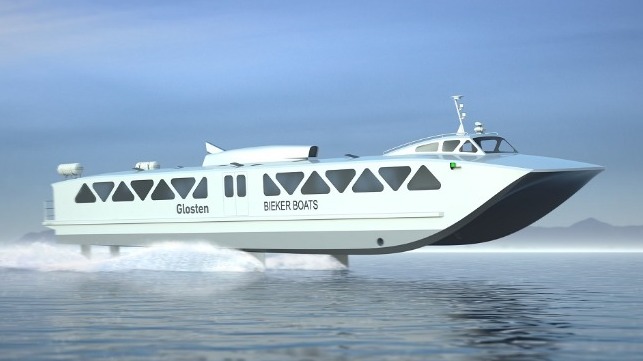Washington Secures Federal Grant for Electric Hydrofoil Ferry Design

The U.S. Federal Transit Administration has picked a novel fast-ferry experiment in Washington State as one of 25 awardees in its Accelerating Innovate Mobility initiative, providing $372,000 in design funding to a consortium led by Washington Maritime Blue. The public-private partnership team intends to use the funding to advance a battery-powered fast foil ferry design and a business case for its operations.
Additional cash contributions of $100,000 have been committed by the Ports of Bellingham, Skagit County, and Anacortes. An additional $139,000 worth of in-kind contributions have been committed by other project partners.
“Our three local ports see this innovation as an opportunity to spur economic recovery in the boat-building world, a critically important industry in our region,” said Patsy Martin, executive director of the Port of Skagit. “There are strong maritime industry clusters in each of our districts that could benefit from the design and construction of these vessels in our communities, resulting in a direct economic impact.”
With this financing in place, the partners will complete the preliminary design for a high-speed passenger ferry powered by battery-electric technology. The novel hydrofoil design will rely on lightweight carbon fiber construction and batteries to speed up travel between urban centers and suburban and rural communities. Its propulsion will be selected to greatly reduce or eliminate fuel use compared to conventional fast ferries.
Kitsap Transit currently operates three hydrofoil-assisted fast ferries – Rich Passage 1, Reliance and Lady Swift – that run on diesel fuel. Each of the 118-passenger ferries uses a hydrofoil that raises much of the vessel’s hull above the waterline, enabling high-speed, low-wake operation between Bremerton and Seattle.
“This [program] supports multiple communities, our sensitive marine ecosystem, decarbonization efforts, job creation and an entire maritime and advanced manufacturing supply chain,” says Joshua Berger, Washington Governor Jay Inslee’s maritime sector lead and the founder and board chair of Washington Maritime Blue. “This is the value of an organized innovation cluster that can bring partners together and leverage multiple funding and financing mechanisms."
The project's other partners include DNV GL; naval architecture firm Glosten, which designed the first hybrid-electric ferry on Puget Sound; and Bieker Boats, which engineered the hydrofoils for Team Oracle's America's Cup-winning sailboat and Kitsap Transit's existing hydrofoil ferries.

that matters most
Get the latest maritime news delivered to your inbox daily.
The project will deliver the design for a zero- or low-emission, high-speed passenger ferry for operation in the Puget Sound. It will also deliver a business model, which will include studies of route viability, shoreside infrastructure requirements, permitting and regulatory requirements, and economic and environmental impacts. The foil ferry will be designed by Bieker Boats and Glosten and include options for fully electric propulsion or diesel-electric propulsion for extended range.
The diesel-electric option could be two to three times more fuel efficient than conventional fast ferries and save 1,500 tons of carbon dioxide annually, according to Maritime Blue. The project also will explore required infrastructure, environmental benefits and impacts, regulatory and permitting needs and possible routes and operators.
